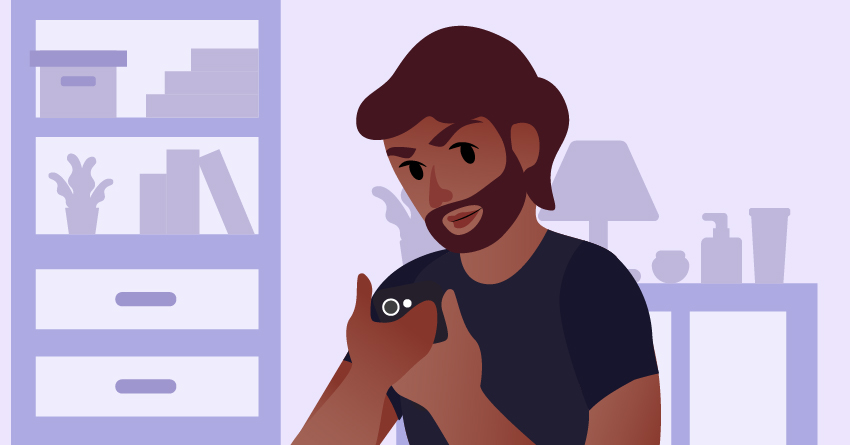
As much as the internet opens doors to various opportunities, it has also opened for offenders to conduct deviant acts, such as grooming. If you’re not familiar with it, we’re here to discuss this activity, signs you should note, and what you can do to help your friend or relative who is being manipulated by a groomer.
What is Grooming?

The general definition of grooming is when an individual (also called the groomer) seeks and builds companionship with another person to manipulate or abuse them. The groomer would constantly be in touch with their victim, send gifts, or even ask the victim to hang out in a public space. They’ll provide a blanket of trust, but not because they genuinely care from the other person, but because they have ill (often sexual) intentions on them.
Grooming victims are often minors who often put their trust in adults. Some of them usually are emotionally vulnerable due to family or school issues and would seek refuge from groomers who present themselves are trustworthy.
Some groomers would even be part of the victim’s family or trusted circle, which increases the victim’s trust in the said person. Once the victim has fully trusted the groomer, that’s when the offender would coerce their victim to abuse and would even threaten to hurt them, their reputation, or their families, just to keep the victim from reporting to their loved ones or authorities.
You might think that this isn’t an issue prevalent in the Philippines. Unfortunately, there’s an alarming rise in grooming cases. In fact, the Philippines was dubbed by the United Nations Children’s Fund (Unicef) as the “global epicenter of the live-stream sexual abuse trade.” Research shows that one in five Filipino children are vulnerable to sexual exploitation online.
The worst part is there are gaps of needed protection under Philippine laws related to online sexual exploitation of children (OSEC). As most of these laws were created pre-internet era, some areas weren’t covered. For example, the anti-child pornography law of 2009 doesn’t explicitly mention the live streaming of sexual content nor the role of social media in the online sexual exploitation of children. Despite having pending bills in Congress that could strengthen penalties against child abuse, there is still no all-encompassing bill for OSEC.
If you or anyone you know is a victim of grooming or any sexual abuse, we suggest consulting legal counsel and prepare the evidence of abuse.
You can also check the links below for further information:
- The Anti-Rape Law of 1997 (Republic Act 8353)
- Anti-Violence Against Women and Their Children Act of 2004 (Republic Act 9262)
- The Anti-Photo and Video Voyeurism Act of 2009 (Republic Act 9995)
Here are various hotlines where you can report online grooming and other OSEC cases:
- Bantay Bata 163 (a toll-free call) — dial 163 for landline and Smart or #163 for Globe
- 1343 Trafficking Actionline — dial 1343 (Metro Manila) or 02 1343 (Outside Metro Manila) or report online through www.1343actionline.ph
- Philippine National Police — hotline 117 or to report directly to the Anti-Violence Against Women & Children Division (Along Pulis Hotline), call the 24/7 hotlines 09197777377 (Smart) or 09667255961 (Globe) or the telephone number (8) 532-6690
- Commission on Human Rights — hotline (8) 294-8704 or mobile numbers 09360680982 (TM) or 09205061194 (Smart), or e-mail reports to chad.pasco.chr@gmail.com
How Grooming Happens

Grooming is a gradual and tedious process. Though there are cases wherein the grooming process can take a few days of talking to one another, most cases take months or years. This is because the groomer invests time in building trust in their victim. The actual abuse, often sexual or financial, only comes once the victim has 100% trusted the perpetrator.
The process usually starts with the groomer befriending the victim. They would either act as the “nice friend” or “love-bomb” their victim. Lovebomb means a person showering someone with gifts and other grand gestures, but with ill intentions. Once the victim is enamored with the groomer, the groomer would now start asking something in return. It’ll start with a small favor that may lead to abusive action. For example, the groomer may ask the victim for some help at their home. For the first few visits, the groomer wouldn’t do anything to harm the victim. They’ll just be casual. Eventually, things will take a sinister turn.
Grooming can also be connected with “catfishing,” wherein the groomer pretends to be someone else or create a persona that the victim likes. It can also take the form of predatory marriage. The predator exploits a vulnerable person (people with disabilities, mental health issues, financial struggles) and coerces them into marriage.
Recognizing Who Is Most At Risk

Children of any age, gender, sexual orientation, background, and socio-economic status can be at risk of grooming and sexual exploitation. However, children who are vulnerable, isolated, have mental health issues, and have physical disabilities are seen to be at higher risk.
One thing’s for sure, though, this deviant act will result in the victim suffering. They may try to cope with their stress and embarrassment through unhealthy coping mechanisms such as alcohol, excessive eating, or substance abuse. They may also go through multiple mental health illnesses.
This is why listening to your child, or a young loved one is a must. If a child reports to you any of the following, contact the authorities immediately and provide support to the victim.
- Being blackmailed with the sexual images, they’re shared with the offender if they don’t carry out the predator’s demands
- Threatened to end their relationship or friendship if the victim doesn’t agree to sexual acts
- Being demanded to have sex with other people or join in group sexual acts
- Getting money in return for the sexual acts
Now, not every child would report this kind of incident; this is why as adults, we should be more observant. If you’ve seen behavioral patterns such as those mentioned below, talk to the child, and see if there’s grooming going on.
Identifying The Signs of Grooming
Before we get into the signs that someone is being groomed, we will briefly share the definition of “child” under the R.A. No. 9344. An individual who is eighteen (18) years old or younger is considered a child.
If a child is a grooming victim, they may show some or all of the following signs. If they show a specific pattern of behavior similar to the mentioned signs below, have a thorough and emphatic discussion with the involved individual.
1They use their phone more often and have become secretive.

Though most children have become dependent on their phones, a grooming victim may become more excessive in their phone usage. You may also notice that they’re secretive about their phone and wouldn’t let anyone even get to hold it.
It’s normal for people to protect their phones as it usually contains private content. Still, it could also possibly mean that the children are talking to someone encouraging them to be secretive. Predators usually do this as they don’t want any adults to find out their grooming schemes.
2They display mood changes.

It’s normal to have mood changes; the monthly period can also play a role. However, mood swings can be excessive for someone going through a huge problem. If a child starts acting out of their usual selves, such as becoming hostile, secretive, anxious, withdrawn and depressed, have a heart-to-heart discussion with the child and see if someone is bothering them.
3The target may even start assuming a new identity.

There are some cases wherein the grooming victim would even assume a new name or identification. Some may also start having an alternate ego online, as demanded by the predator.
4They start to avoid talking about what they’re doing.

One of the common signs of abuse is isolation. If a child starts disengaging in social conversations and would be defensive when asked questions, offer support without probing them for information. Don’t push them to answer if they’re not ready to share what they’re going through. Just establish yourself as a reliable and non-judgemental ally in their life. Once they’re ready to talk to you, simply listen and take it all in, then start planning the necessary steps to catch the perpetrator.
5The child or young person may even seem more distant emotionally to you.

Related to the previous sign, if you’re the mother or sibling of the child, you may notice a change in the way they interact with you. They may no longer talk with you about their daily whereabouts and thoughts. This could possibly be linked to the creepy conditioning of the abuser. Most groomers would often make their victims believe that their parents, siblings, and other authoritative figures, don’t care about them are just “jealous.”
6They start to receive unexplained gifts like clothes, toys or electronics.

Another alarming sign that a child is talking to a groomer is if they’ve suddenly received gifts and money from an unknown source. If you’ve seen them with expensive or romantic gifts and the child wouldn’t admit the person who’ve sent these items, it could’ve come from someone with shady intentions, such as a groomer.
7They start talking about a new “friend”.

Another sign to note is that the child started talking about having a “romantic partner” but would never admit the person’s identity. They would make excuses if you start asking them about this person and even be defensive if you start talking about their “mystery partner.”
8They exhibit desensitization to touch.

Suppose you’ve noticed that your child, sibling, or relative has become more “open” to being touched by strangers (you may see this at a party or public gathering). In that case, someone may have been encouraging this “touchy-feely” behavior. As we mentioned before, the groomer tends to carefully manipulate the victim, making them believe that it’s okay to cross their boundaries.
9The young person may start to act “more mature”.

Children tend to get inspired by adults, as they have an idealized version of what an adult is in their minds. However, it’s not normal for a kid to start acting “maturely” and wearing skimpier clothing. This is most likely due to the mind conditioning that the groomer has been doing to the victim. They may mention that the child is more mature than their peers and make them believe that it’s an appealing trait.
10They don’t share the full location of their “meetups” with friends.

Another alarming sign that a child is maybe under the grooming process is that they always inform you that they’ll be meeting with friends but wouldn’t share full details of the location.
For example, let’s say you have a young, female cousin. She casually mentions that she’s excited to meet some of her friends at a mall. When asked where resto are they planning to meet up, she wouldn’t give a concrete answer. “Oh, we’ll figure it out there.” And when asked who the friends are, she may also be vague about it.
The Stages of Grooming
When a person is being groomed, they’ll unlikely tell anyone that they are indeed victims. Since the groomer only shows their kind and trusting side, the victim may think they’re in a loving relationship and may even defend the groomer should there be a conflict. This is why the adults around the victims must be able to spot the stages of grooming before it’s too late. Here are some of the possible steps a groomer may take to manipulate and win the victim’s trust.
Though grooming can take many different forms, it often follows a similar pattern:
1Predators start gaining access to their victims.

Groomers would often start observing possible victims and picking them based on how vulnerable and easily accessible they are. The abuser may go online, or if they have access to multiple minors, such as a teacher, sports coach, life coach, and the like, they may start treating their victim in a special way.
2They develop trust through gifts and providing undivided attention.

Once the groomer has established rapport with their target, they may start giving gifts or doing some favors for the victim. Now, the gift-giving wouldn’t be grandiose in the beginning. It may start with something small, like a chocolate bar. Eventually, the gifts may become more expensive and romantic.
3They will pretend to share interests as the victim.

Groomers would often join social media groups or play games wherein most users are kids, teens, and young adults. Aside from scouting potential victims, they also familiarize themselves with these games/interests to help establish rapport with their current target.
4They gauge the target’s accessibility.

People often see groomers as people who are just desperate for a romantic and sexual connection. They don’t see them pre-meditating the grooming. However, most groomers plan it out first and would even engage in a risk assessment to determine how accessible the victim is. They may check the target’s relationship strength with friends, family, and roommates by asking the victim and stalking them on social media platforms.
5The perpetrator fills their target’s needs.

After further learning the victim’s story, the abuser will use this to their advantage, ensuring that their next actions will fulfill the child’s emotional needs. They may use tactics such as gift-giving, compliments, and other things that a child may lack in their life.
6They initiate desensitization to touch and discussion of sexual topics.

After establishing the connection, the groomer would start getting what they’ve actually wanted from their victim. At first, they would touch the victim in simple and harmless ways, such as hugging, tickling, and wrestling. Later, it would escalate to something sexual, such as massages, cuddling in bed, and the like.
7They start sexualizing the relationship.

Once the groomer has established that the connection they have with the victim is “romantic” and “fueled by love,” the perpetrator would now start sexualizing the relationship. The groomer may start mentioning sex to the victim, showing them the activities through pornographic video, or create situations that’ll enable them to be sexual, such as swimming together.
8They initiate touching or hugging the child.

As mentioned earlier, the perpetrators would often initiate romantic or sexual activities in the “relationship.” They would test the waters by touching the victim in a friendly manner, such as putting their arm around the child or asking for a hug. If a kid wasn’t taught about consent or boundaries, they would probably just accept it and see it as a way people express affection for one another.
9They isolate their victims from their loved ones.

Once the groomer has the victim wrapped around their finger, they would start demanding the victim to isolate themselves from their friends and family. They will condition the poor child’s mind that they’re just jealous that the victim is in a relationship or just there to stop the victim from being free. They would appear as if they’re concerned for the child’s well-being but actually preventing the victim from accessing a support group and ensuring that no one knows about their relationship.
10The predator maintains control.

At the latter stage of the grooming cycle and once the sexual abuse occurs, the groomer would now commonly use secrecy, blackmail, blame, and threats to keep the child from doing sexual acts. Aside from making the child believe that they’re the only one who could meet their needs, they’ll also threaten that if the kid leaves the relationship, they will expose the sexual acts that the child has done. And because sex is such a taboo topic, most children would succumb to the orders instead of admitting the sexual aspect of their relationship.
Tips on How To Avoid & Deal with Grooming

Adults play a critical role in helping and stopping grooming from happening. No kid shouldn’t be subjected to this traumatizing activity. Here are some general tips that you or your loved one can do to help their child, friend, sibling, or relative experience something like this.
1Intervene and communicate your concern.
If you’re witnessing grooming happening in real-time, intervene. Don’t wait for another adult to check on the child. You’re already there— help out. If no one would intervene, the child may be confused about the situation and may even get closer to the perpetrator.
Here’s an example of how to call it out:
“Please stop right here… It looks like you are forcing Mary to hug you. She looks uncomfortable. We let Mary decide if and how she wants to show affection.”
2Do not avoid talking about predators for fear of upsetting the child.
We get that it’s uncomfortable to talk about predators and groomers to your children. But talking about these things is crucial to protect your kids, siblings, or younger relatives from potential harm. It’s also best to ask if there’s someone in their life that’s making them uncomfortable.
3Offer a safe space to talk openly.
Don’t judge them once the child starts talking about someone or their previous experience. Don’t start interrupting between the discussion and call them names for what they’ve done with the predator. Keep in mind that the predator has conditioned the child to think that you’re one of the jealous and untrustworthy people. Prove that you’re someone they can trust by being more open.
4Limit the interaction between target and perpetrator.
If the child is a potential grooming victim, their safety should be your number priority. Never let them communicate with the groomer. It’s also important that you explain to the child why you’re limiting their access to the internet or on the groomer, as they may get the wrong idea and think that the abuser is correct all along— that you just want to ruin their life.
5Be a sympathetic listener to your child.
When approaching the child in difficult topics such as this one, it’s important to reassure them that you’ll still love and care for them no matter what. Don’t use taunting or punishment tactics when having an uncomfortable discussion; remember that the child is also a victim here.
If the child has report suspected abuse, in which sexual abuse, blackmailing, or other forms of abuse is involved, call the authorities as soon as possible.
6Remind the child to never share personal information online.
Aside from helping them catch the predator, it’s also important to remind the child to stop messaging their private details on online strangers. Explain how risky it is and how it can put them in harmful situations.
7Never let the child meet anyone online on their own.
Even if they’re on the way to young adulthood, children shouldn’t be meeting strangers alone. Every first meetup must be accompanied by a trusted adult.
8Ask the child to refrain posting too much photos and videos online.
You don’t have to police every photo your child, sibling, or young relative shows on the internet. Remind them that they shouldn’t put so many photos out; the photos and videos may be used for catfishing, grooming, and other deviant online activities.
9If you’re the child, tell your parents if you see distasteful messages on your accounts.
If you’re the child in this situation and someone is being creepy online, let your parents or any trusted guardian know. Don’t keep them to yourself as you’re just tolerating the abuser to partake in this vile act.
10If it sounds too good to be true, it’s most likely a trap.
If someone is offering you something too good to be true, such as unlimited money, gifts, undying love, and other questionable gestures, the person sending those messages most likely has ill intentions. Report and block the accounts so that other people will not encounter them.
Takeaway
When someone you know has been a survivor of any abuse, whether it’s started as grooming or not, the best thing you can do to that person is to be a supportive and non-judgemental friend. Don’t judge them for getting enamored with the abuser, as those vile people are master manipulators. It’s never the victim’s fault.
Feel free to share this article to help spread awareness about this topic and click here for more articles like this one.


















